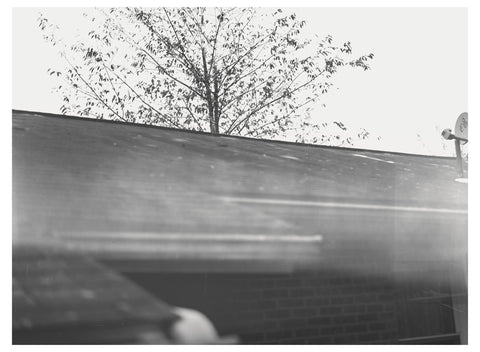
In 1960s Italy, as in so many other countries that were recovering from the ravages of World War II, the unrelenting urban sprawl led to a phenomenon that was new to some degree but also logical and inevitable, and that subverted the accepted criteria of what had been considered ‘photographable’. As a result of the unprecedented transformations of the territory, the concept of the landscape gradually mutated, veering towards a new focus on spaces and territories that had previously been deemed undefined or marginal, rather than more canonical sites.
Vacant lots, terrains vagues, and industrial estates began to be seen through different eyes: the eyes of a farmer stunned at the inexorable shrinking of the countryside; the eyes of artists and theorists who saw an upset in the balance between the centre and the periphery and started to actively think about the obsolescence of this increasingly blurred duality and its consequences (plate 1).

Guido Guidi has undoubtedly been one of the most radical of the photographers who undertook this reflection, although it should be noted that his has not been a literal or descriptive approach. Because even though the most visible part of Guidi’s work consists of images of geographical zones on the outskirts of the city – areas that could have been considered ‘free zones’ without aesthetic connotations at the time – his explorations actually extend far beyond the subject matter of his photographs. One possible starting point from which to get an idea of the scope of his artistic oeuvre in relation and in response to the sociocultural context of the time is through a reassessment of the criteria according to which something was judged to be obvious, anodyne or self-evident. More specifically, Guidi’s approach tended to redefine the categories that were applied from the 1960s onwards to these new spaces on the margins, in contrast to the prescribed beauty of monuments or of idyllic landscapes as established by the art institution. However, Guidi did not seek to endow these spaces with analogous aesthetic connotations or to monumentalize them, as eventually occurred in so many other cases. Instead, he set out to freely observe what lay beside, under, or in the shadow of these sites at which the imperative to photograph was prescribed.

By methodologically insisting on looking in the ‘opposite direction’ to the dictates of the canons of the time, which clustered around the historic city centre, Guidi predictably elicited the surprise and consternation of his colleagues. Faced with a bleak view of a wasteland, they would rebuke him: ‘What are you photographing over there, Guido? There’s nothing there!’ It is this supposed invisibility, this ‘there’s nothing there’ – ‘nothing’ to photograph – that perhaps best explains some of the misunderstandings in interpretation of his approach. And at the same time, it may also point the way to a renewed understanding of his images, given that the meaning of emptiness is far from a minor matter in his work. In many of Guidi’s photographs, particularly those that he took from the 1980s onwards with a 10 x 8 inch camera, we can make out, at most, a streetlight with its wires strung across a street; a stretch of paved road, a kerb, perhaps a vehicle; anonymous housing, factories, workshops, machinery, remains… Should we interpret them as a chronicle of destruction and of the meaninglessness that followed? As a fascination with decline or banality? Although they are neither of these, the reactions of the first people who saw his photographs were probably not unlike those of visitors to George Eastman House in Rochester 3 who were dumbfounded on finding themselves before Lewis Baltz’s industrial estates, Stephen Shore’s empty streets, and what John Brinckerhoff Jackson had only recently described as the ‘vernacular landscape’; 4 in other words, the gap between the expectation of a certain idea of landscape and how it should be represented.

The books on landscape photography that were published from that time onwards, and very particularly the critical success of the exhibition New Topographics: Photographs of a Man-Altered Landscape – which Guidi acquainted himself with at the time 5 – tended to impose a simplification that has rarely been challenged and that can be summed up as an extreme polarisation between an idealized representation of nature on the one hand, and the damming evidence of its degradation on the other. Nonetheless, not all photographic representations operate according to the same representational assumptions, and not all images that depict a landscape are reflections on the territory itself. In fact, what Walker Evans had only recently defined as ‘documentary style’ photographs 6 could often be confused with images that were more focused on performative or phenomenological aspects, and barely or not at all concerned with describing a specific place. Guidi’s work would tend to fit into this second category, notwithstanding the fact that its complexity resists attempts to classify it too lightly. The vast reach of the territory explored by the photographer in the course of a career spanning more than forty years makes it an impossible endeavour. Nonetheless, it is certainly possible to identify certain key aspects that offer us an insight into his modus operandi – which is both obvious and invisible – and reveal the scope of his artistic project, as can be seen in this exhibition curated by Agnès Sire. Her choice charts a path that connects previously unpublished images with others belonging to open-ended projects and to specific publications, and the curator is able to integrate previous edits carried out by the photographer himself, as well as those by photographer John Gossage, editor of Guido Guidi. A New Map of Italy, whose selection has been partially included in the exhibition.

3. Viewing the famous exhibition entitled New Topographics: Photographs of a Man-Altered Landscape. See the reproduction of the conversation of some visitors, in the catalogue New Topographics: Photographs of a Man-Altered Landscape (Rochester: George Eastman House / Steidl, 2010), p. 9.
4. John B. Jackson, Discovering the Vernacular Landscape (New Haven: Yale University Press, 1984).
5. With this exhibition, and another show curated by William Jenkins at George Eastman House that same year, The Extended Document: an Investigation of Information and Evidence in Photographs, exploring the convergence of photographic practices inspired by conceptual art with those based on the actual field of photography, and revolving around the hypothesis that ‘the extended document’ should make it possible to challenge the credibility of the image.
6. Thanks to John Szarkowski, Walker Evans received enormous attention in the last decade of his life. He took advantage of this reposition of his work in the appropriate sphere, and to redirect critical interpretations away from the interests of photojournalism. In 1971 Walker Evans settled the question of the ‘documentary’ to label it as follows: ‘Documentary? That’s a very sophisticated and misleading word. And not really clear. (...) The term should be documentary style. An example of a literal document would be a police photograph of a murder scene. You see, a document has use, whereas art is really useless. Therefore art is never a document, though it certainly can adopt that style’. Walker Evans, in Olivier Lugon, Le style documentaire. D’August Sander à Walker Evans. (Paris: Macula, 2001), p. 18.
Excerpt from "Through the empty room" by Marta Dahó, from Veramente by Guido Guidi, published January 2014.






